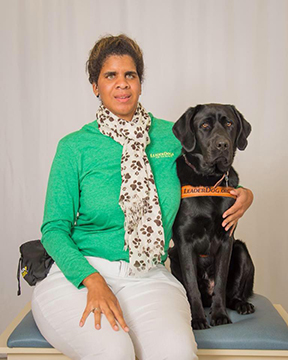April 25, 2018, marks the 90th year of man’s best friend serving as guide dogs in the United States.
There are currently around 10,000 guide dogs working in the U.S. according to the National Federation of the Blind and three are serving on the campus of UTM.
Ashley Jackson, a blind and deaf Family and Consumer Science major at UTM, is currently learning how to work with a guide dog named Bunker, a black Labrador, to help her get around campus. Jackson spent three weeks at Leader Dogs for the Blind in Rochester, Michigan, in August, training with Bunker and continues to train everyday with him.
Jackson said even though they had been together since August, they face new challenges, like getting lost, since both Bunker and her are still learning to work together.
“I’ve been training with him every day. We still have challenges to overcome every day and getting used to each other’s ways of things. I guess it may be next year before we may be a completely good team.”
From getting to and from classes, maneuvering staircases and avoiding traffic to providing companionship, Bunker has helped Jackson in many ways. He helps provide a sense of independence for Jackson, allowing her to do more than before.
While Bunker is only one of three guide dogs on campus, UTM has seen a massive increase of Emotional Support Animals (ESA’s) in the past few years. Disabilities Specialist Jeanneda Gilbert from Disability Services says there are 57 ESA’s on campus.
The very first guide dog issued was a German Shepherd named Buddy, who assisted Morris Frank, a man left blind by two childhood accidents in New York City. One day in 1927, Morris spent 5 cents on The Saturday Evening Post that his father read to him, in which an article by Dorothy Harrison Eustis, an American dog-breeder working in Switzerland, was featured.
Eustis worked training German Shepherds as police dogs but had also trained them to be guide dogs. Morris wrote back begging her to teach him how work with a guide dog and eventually traveling to Switzerland to work with Eustis in person. He began working with Eustis and two German Shepherds to determine which one was more compatible with him, eventually settling on Buddy.
Buddy and Morris returned to the U.S. in 1928 to debut his abilities in the middle of a busy intersection in New York City. Witnesses and reporters surrounded the streets as Buddy and Morris made it across without inflicting harm, bringing awareness to the assistance capabilities of dogs.
The first guide dogs were used in Europe during World War I as eyes for German soldiers whose eyes had been damaged by exposure to mustard gas but were expanded to serve the disabled in times of peace.
Paige Sanders, a sophomore Ag Business major from Springfield, Tennessee, depends on her ESA Luci, a Lab/Border Collie mix, in a different way than Jackson. While guide dogs are for the visually impaired, ESA’s serve as comfort animals and can help relieve anxiety and depression.
Sanders depends on Luci’s presence to take the place of anxiety medicine. “It definitely helped with my anxiety a lot! When I came to college, I was diagnosed with anxiety and put on a lot of medicine that I didn’t want to be on. I wanted to come home to someone who was excited to see me,” she said.
Sanders said that drugs do not always work for every person, and she found that an ESA was the medicine she needed to relieve her anxiety.
There are many differences between guide dogs and ESAs but the most important difference is to not approach or distract a guide dog because it can harm the handler. There are certain rules and regulations that must be followed as set by the Americans with Disabilities Act. ESA’s are used as a therapeutic form of treatment while service dogs are trained to perform a certain task for the handler.
“The most important thing is not to pet him or talk to him when I am with him or standing talking to someone because he gets more attention when they just look at him,” Jackson said.
Jackson has faced many issues with Bunker getting distracted, causing her to become lost. As Bunker and Jackson are still adjusting to each other, approach Bunker cautiously as to not distract him.
Whether it be an ESA or a service dog, man’s best friend has served faithfully and will continue to bring joy with their presence everywhere they are allowed.
(Ashley Jackson and her service dog Bunker \ Photo credit/ Leader Dogs for the Blind)


